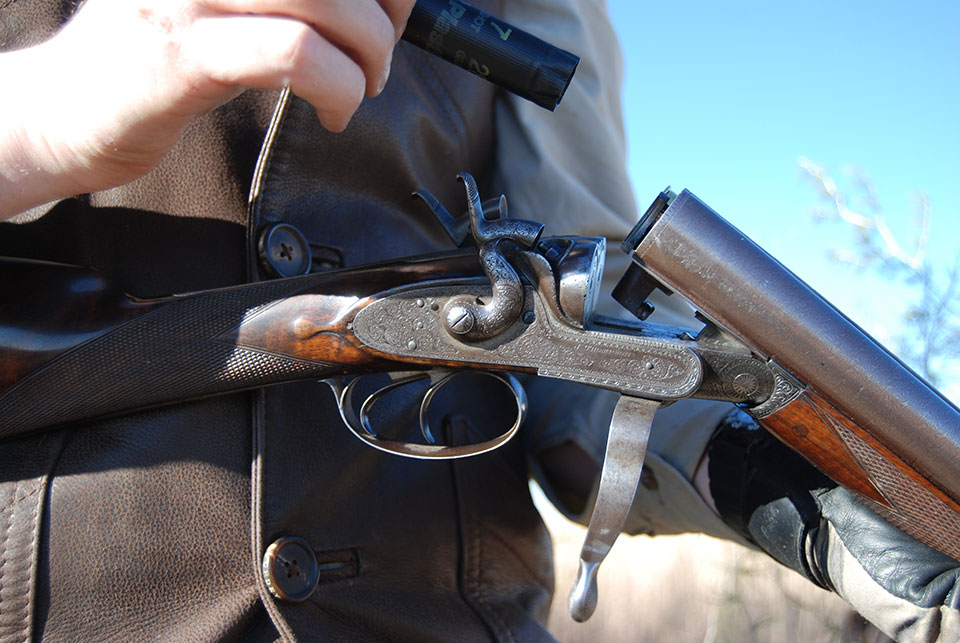As I packed for our annual bird hunting Safari in Africa this August, a couple of contributors to a shooting website I frequent uttered disparaging remarks about the reliability of old guns for long trips; ”Better take a modern o/u if you are going all that way”. I put my 1870 12-bore J. Thompson in the case and ignored them. However, my friends and clients all turned up in Johannesburg with Brownings, apart from Jon Hansen who unpacked a Purdey sidelock!
That trip got me thinking. A lot of people consider turning up to a shoot with an old hammer gun is a bit of a novelty and some shooters bring one out occasionally for fun. What most people seem to believe, though, is that modern guns are the ‘proper’ shooting tools and the old stuff can’t be trusted when the going gets tough. Are they right? Should we consider our vintage guns as special curios only fit for dry weekends now and then?
I don’t think so and this little jaunt to Orange Free State to shoot pigeons, francolin, guinea fowl and ducks proved that I may have a point. I fired 2000 shells in ten days, killing 896 head of game. Despite being 150 years old and very basic in terms of operation, my old girl never missed a beat: no misfires, no jams, no bits falling off or gumming up. I had to scrub out the chambers after a week as the powder residue was making the shells fit tight, but that was it! Ammunition was Eley ‘Pigeon’ 30g loads and 24g Trap loads.
The Brownings fared not so well. One refused to allow the forend to be removed. Another could not be re-attached after dismantling, yet another started to malfunction in the field – no second shot due to a single trigger problem. Suddenly 19th century technology and workmanship looked a bit more sensible. Fortunately, the owners had brought back-up guns and they needed them. Not me! I wonder if any of those Brownings will still be at work in a century. Somehow I doubt it.
So, what is it about a gun which makes it reliable or otherwise and how can we assess the old against the new?
Mechanics.
My old Thompson is a bar-action hammer gun with simple, beautifully hand-made rebounding locks. The internals are trouble free and require no maintenance.
The operating system is by Jones rotary under-lever. It has no springs to fail. If the action gets a bit loose, pushing the lever a fraction farther will tighten it up again.
No ejectors, no single trigger, no barrel selector. In this case ‘less is more’ as none of these things can go wrong and ruin your trip.
Materials.
All the parts of the Thompson were hand filed out of the finest steels and the quality of steel needed for each part was selected accordingly and hardened or not, as necessary. Wear is minimal. Modern guns are made from alloys and metals which suit machining and will ‘do’. They fit after a fashion but wear faster.
The wood is close-grained and would have been fully and naturally air dried for years before being used. It does not move. Modern stock wood is often kiln dried, more open grained; it is more brittle and affected by changes in atmosphere more. Last year in |Africa a friend’s Beretta cracked through the stock from a few days of solid pigeon shooting.
Workmanship. Every metal part is hand-fitted to the wood perfectly. Recoil permeates naturally through the gun and harms nothing. Modern guns have far less perfectly fitted components and angles are less graceful through the line from breech to butt. They have to absorb recoil through bulk rather than perfect line.
John’s Purdey is a complicated action (Beesley’s self-opener) but so well made out of best material that it is unlikely to fail under heavy use. I put thousands of shells through my 1889 model and it never needed any attention at all in 10 years ownership. Like my Thompson, the Purdey coped effortlessly with the workload.
All the above considered, I’d wager that my old Thompson and John’s Purdey will stand up to a lot more hard use without becoming faulty than most of the ‘sensible’ choices people take on long haul trips to shoot big numbers.
So, if old guns are your thing, don’t save them for special occasions, bin the modern kit and treat yourself to properly made guns with style and longevity every time you go out, wherever it may be. My Thompson has been to Africa four times already and it will be the first name on my list when I start my plans for 2012. Vintage British guns are no handicap in the field; they are an advantage: in handling, reliability and shooting quality. Take them out and make them work for you.
Published by Vintage Guns Ltd on (modified )




